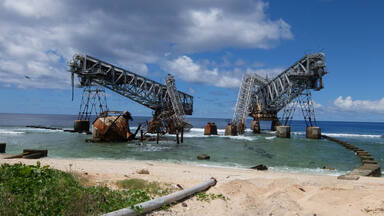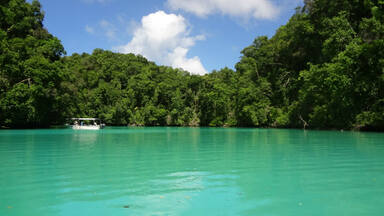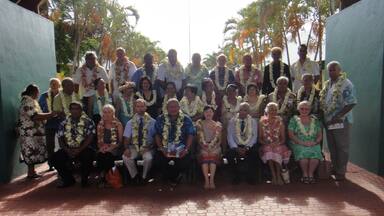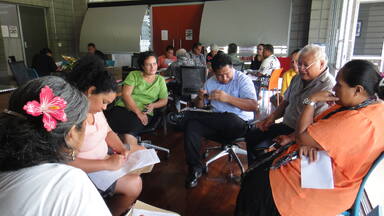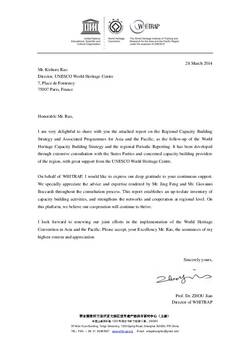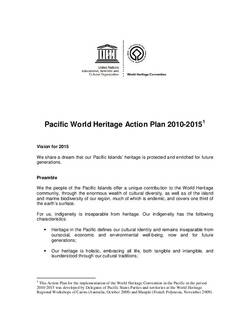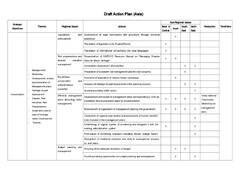The second cycle of Periodic Reporting for the Asia and Pacific was launched by the World Heritage Committee at its 34th session in Brasilia, Brazil in August 2010. All 41 State Parties to the Convention in Asia and the Pacific actively participated in this cycle and worked together on this vital component of the Convention.
Results from the Questionnaire for Periodic Reporting
The results of the second cycle have been presented to the World Heritage Committee in 2012 at the 36th session in St. Petersburg, Russian Federation, in June - July 2012.
These results were achieved through the active participation of the States Parties of Asia and the Pacific. All requested 166 SOUVs were submitted, all of these statement, bar one were reviewed as complete. From 41 States Parties of Asia and the Pacific, all 41 States Parties submitted the Periodic Reporting questionnaire Section I; of the 198 properties, all 198 properties have submitted the Section II. From the 96 properties, 68 properties have submitted cartographic information for Retrospective Inventory.
Objectives
The second cycle of Periodic Reporting has provided all States Parties of the Asia and the Pacific region an opportunity to assess the progress and challenges that have occurred since the first cycle of Periodic Reporting, to allow for a review of the current situations in all the States Parties and the World Heritage properties in the region for the first time in the history of the Convention.
Periodic Reporting provides four main purposes
- To provide an assessment of the application of the World Heritage Convention by the State Party;
- To provide an assessment as to whether the Outstanding Universal Value of the properties inscribed on the World Heritage List is being maintained over time;
- To provide up-dated information about the World heritage properties and to record the changing circumstances and state of conservation of the properties;
- To provide a mechanism for establishing and enhancing regional co-operation and exchange of information and experiences between States Parties concerning and implementation of the Convention and conservation.
Periodic Reporting process is important for more effective long term conservation and management of the properties as well as for further strengthening the credibility of the Convention.
The World Heritage Committee invites States Parties to submit periodic reports every six years, and requests the Secretariat, the World Heritage Centre in collaboration with the States Parties and the Advisory Bodies, to develop regional strategies as an outcome of the periodic reporting process. These Strategies should be designed to respond to specific characteristics and needs of the regions and should promote regional cooperation between State Parties.
Scope
The States Parties of Asia and the Pacific were requested to submit the following documentation:
- Draft retrospective Statements of Outstanding Universal Value (SOUV) of the World Heritage properties inscribed from 1978 to 2006;
- Periodic Reporting online questionnaire: The Responses are comprised of the
- Section I (Implementation of the World Heritage Convention at national level) for all the States Parties to the World Heritage Convention
- Section II (State of conservation of each World Heritage property) for the World Heritage properties inscribed from 1978 to 2010;
- Requested cartographic information on the World Heritage properties inscribed from 1978 to 1998 for Retrospective Inventory
Information required for Periodic Reporting - 166 properties were requested to prepare draft retrospective SOUVs;
- 41 States Parties were requested to answer Section I and 198 properties in 31 States Parties were requested to answer Section II for the Periodic Reporting online questionnaire; and
- 96 properties out of 106 properties inscribed from 1978 to 1998, which are located in 19 States Parties, were requested to submit cartographic information for Retrospective Inventory.
Implementation Strategy
Periodic Reporting was coordinated by the World Heritage Centre in close cooperation with the national focal points, site managers, international resource persons, the three Advisory Bodies and the– International Council on Monuments and Sites (ICOMOS), International Union for Conservation of Nature (IUCN), and International Centre for the Study of the Preservation and Restoration of Cultural Property (ICCROM) and UNESCO Field Offices.
In order to facilitate the successful implementation of Periodic Reporting, all the States Parties were invited to designate national focal point responsible for coordination at the exercise at national level before the launching of the exercise. A system of “mentoring” was introduced to accompany the focal points and site managers throughout the process to ensure the provision of technical support and close guidance especially in drafting retrospective Statements of Outstanding Universal Value, in addition to assistance offered by UNESCO. The World Heritage Centre appointed five “mentors/international resource persons” to this effect.
Key Actors involved in the process
- National focal Points: Answering Section I and coordination for the submission of both Section I and Section II together.
- Site managers: Drafting retrospective SOUVs of the properties of their responsibilities; respond to the questionnaire Section II, prepare cartographic information for Retrospective Inventory.
- Mentors/International resource persons: Provision of technical support and guidance
- Advisory Bodies: Provision of technical support and guidance
- UNESCO Field Offices: Provision of technical support and guidance to States Parties in close consultation with the World Heritage Centre;
- UNESCO World Heritage Centre: Provision of technical support and guidance to States Parties, coordination between the States Parties and the Advisory Bodies for the finalisation of the draft retrospective SOUVs; compilation of the Periodic Report.
The Periodic Reporting questionnaires were translated into various languages (Russian, Persian, Thai, and Vietnamese) by UNESCO Field Offices to assist site managers.
Workshops and Activities
Periodic Reporting 2010-2012 Workshops and Activities Asia and the Pacific
The Second cycle of the Period Reporting two year exercise was first established through the preliminary workshops, which were held in three regions of Asia and the Pacific
-
Pacific region - Maupiti, French Polynesia, November 2009
- East and Southeast Asia - Taiyuan, China, April 2010
- West, Central and South Asia - Dehradun, India, June 2010
The objectives of these workshops were to “train the trainers”, where the guidance and explanation on the preparation of draft retrospective Statements of Outstanding Universal Value, Periodic Reporting questionnaires, and Retrospective Inventory were provided to national focal points.
Sub-and national regional workshops and other types of activities and assistance
Throughout 2010 and 2011, there has been a whole range of national and sub-regional workshops initiated by the individual or groups of State Parties, which have been organized in conjunction with the UNESCO Field Offices. These meeting in the form of workshops were vital in the beginning stages for explaining the process to site managers, and to jointly work on the Periodic Reporting questionnaire. Also informal meetings took place throughout the two year period and were very productive and have been fundamental to the success of this whole process. The active engagement at the national and regional level that has taken place must be recognized as highly important for the successful implementation of Periodic Reporting. The collaborative effort and their ultimate achievements are the product of everyone involved, focal points and site mangers in particular.
List of national and sub-regional workshops
- National workshop for Nepal (Kathmandu, Nepal, August 2010)
- National workshop for Iran (Tabriz, Iran, September 2010)
- National workshop for the Philippines (Vigan, Philippines, October 2010)
- National workshop for Indonesia (Jakarta, Indonesia, October 2010)
- National workshop for Bangladesh (Dhaka, Bangladesh, November 2010)
- National workshop for natural properties in Thailand (Khao Yai, Thailand, January 2011)
- National workshop for Viet Nam (Ha Noi, Viet Nam, May 2011)
- National workshop for natural properties in Indonesia (Jakarta, Indonesia, June 2011)
- National workshop for Sri Lanka (Colombo, Sri Lanka, July 2011)
- National workshop for Iran (Shiraz, Iran, September 2011)
- Sub-regional workshop for Central Asia (for Kazakhstan, Kyrgyzstan, Tajikistan, and Uzbekistan: Tashkent, Uzbekistan, September 2010)
- Sub-regional workshop for natural properties in South Asia (for Bangladesh, India, and Nepal: Dehradun, India, November 2010)
- Sub-regional workshop for Southeast Asia (for Cambodia, Indonesia, Malaysia, Philippines, and Viet Nam: Jakarta, Indonesia, December 2010)
- Sub-regional workshop for South Asia (for Maldives and Sri Lanka: Colombo, Sri Lanka, December 2010)
- Sub-regional workshop for South Asia (for Bangladesh, Bhutan, Maldives, and Nepal: Kathmandu, Nepal, April 2011)
- Joint meeting for Mongolia and the Russian Federation for the trans-boundary property of Uvs Nuur Basin (Ulaangom, Mongolia, May 2011)
Overview of World Heritage properties in Asia and the Pacific
As of 2012, in Asia and the Pacific there are 962 properties on the World Heritage List, 205 (22%) of which are located in the region. These 213 properties consist of 148 cultural (70%), 55 natural (26%), and 10 mixed (4%) properties, formulating an essential part of global cultural and natural heritage that World Heritage Committee holds as having Outstanding Universal Value.
Summary of outcome
The key issues for the Asia and the Pacific region that have been highlighted in the Periodic Reporting process have been found to focus on four main areas: management plans, sustainable funding mechanism, community involvement and benefit sharing and regional cooperation.
Management plans/systems
All the States Parties in Asia and the Pacific agreed that the development or improvement of a management plan of a World Heritage property is a priority. A management plan needs to focus on the safeguarding of the Outstanding Universal Value of the property, and it needs to be implemented with a time bound action plan and monitoring of the plan be maintained. Management plans/systems should be legalized or endorsed by the States Parties and actively and effectively implemented in all properties.
Sustainable funding mechanism
Throughout the region, a large portion of the allotted fund comes from the national governments; though, international funding also plays an important role in various sub-regions. It has become increasingly clear; however, that this funding is inadequate. Funding from governments can never meet the growing financial demands in the conservation and management of properties, and it is also not realistic to keep relying on international funding. This means that the establishment of a more sustainable funding mechanism for properties urgently needs to be devised. Also strengthening partnership with the private sector and the effective use of financial returns from tourism should be further explored in the entire region.
Community involvement and benefit sharing
Communities must be involved in all areas of activities for the implementation of the World Heritage Convention – from the preparation of inventories, Tentative Lists, nomination dossiers, to the conservation and management of the properties. Awareness-raising, education and capacity-building are essential in order to give adequate knowledge and skills to communities, and to engage them in all related activities. The higher a communities’ awareness is the more they will contribute to the management of properties. Communities could also be involved in monitoring of properties, complementing the available human resources, which are commonly insufficient. Undeniably, communities are crucial in all aspects of activities discussed throughout the Periodic Reporting exercise.
Regional cooperation
Through the implementation of Periodic Reporting, national focal points and site managers worked together in various workshops. These workshops provided them with an opportunity to exchange information and experience on various issues related to the implementation of the World Heritage Convention. All participants, particularly site managers found this exchange useful. Meeting together several times facilitated the gradual development of a network of focal points and site managers. Many States Parties expressed their wish to maintain this network, which could enhance their day-to-day work on the conservation and management of World Heritage properties. An exchange of information and experiences is highly useful for the addressing of factors affecting properties. Some of the factors, especially non-human factors, often lack immediate solutions.Areas of cooperation can also be found in a commonality to approaching heritage. The establishment of databases on studies and conservation will be a useful tool, as well as the development of a network of focal points and site managers.
Follow-up to Periodic Reporting
Actions Plans
Based on the outcome of the second cycle of Periodic Reporting, the States Parties in Asia developed the Suwon Action Plan in Suwon, Republic of Korea, in December 2011, and the States Parties in the Pacific reviewed and adjusted the Pacific Action Plan 2010-2015 in Apia, Samoa, in September 2011, based on the outcomes of Periodic Reporting to reorient the efforts to address their identified factors and specific needs.
The lack of resources will be the significant challenge for the implementation of the Action Plans. To date, some State Parties have pledged to organise sub-regional workshops on various topics, whilst State Parties have already organized national workshops or developed national plans.Periodic Reporting has provided an opportunity to know about the most updated information on what is happening with the implementation of the World Heritage Convention and the state of conservation of all the properties in Asia and the Pacific. The outcome of the Periodic Reporting must be fully utilized to ensure the action plans are implement during the near future.
i. The Suwon Action Plan
The Suwon Action Plan identified the priority issues for entire Asia region, as well as the sub-regions:
- All States Parties unanimously agreed that the development, review, and implementation of effective management plans/systems is of paramount important and these should correspond with Outstanding Universal Value of the individual properties, and where possible time bound action plans for implementation should be established.
- All States Parties in Asia agreed that the issue of disaster risk reduction and risk preparedness is among the top priorities for attention in the region.
- States Parties in Asia all agreed that regional cooperation is currently lacking and needs improvement; this is to be achieved through the establishment of network for all focal points and site managers.
- Most sub-regions in Asia expressed the importance of greater community involvement and benefit sharing.
ii. The Pacific Action Plan
The States Parties in the Pacific agreed that actions that will be taken under the Pacific Action Plan 2010-2015 should be oriented to address five major factors that are adversely affecting all properties in some aspect; (invasive/alien species, climate change and severe weather events, service infrastructure, loss of social and cultural use of heritage, and transportation infrastructure) and five training priorities (conservation, education, risk preparedness, visitor management, and community outreach).
Decisions / Resolutions (3)
The World Heritage Committee,
- Having examined Document WHC/19/43.COM/10A,
- Recalling Decision 40 COM 10B.1 adopted at its 40th session (Istanbul/UNESCO, 2016),
- Welcomes the progress made in the follow-up of the Second Cycle of Periodic Reporting in the region of Asia and the Pacific;
- Thanks the Governments of Japan, Malaysia, the Netherlands, the Republic of Korea and the United States of America for their contributions towards supporting follow-up activities to the Second Cycle of Periodic Reporting in the region of Asia and the Pacific;
- Takes note of the progress made on the Silk Roads nomination process, initiated by the Asian States Parties in collaboration with the World Heritage Centre, also notes the strategic shift from nomination to conservation, in view of the region’s growing conservation issues linked to development, and commends the fruitful international cooperation between the national institutions of various States Parties in the region;
- Reiterates its invitation to States Parties in Asia and the Pacific to actively implement the relevant sub-regional Action Plans before the start of the Third Cycle of Periodic Reporting, foreseen in September 2020, and encourages them to intensify their efforts towards the implementation of follow-up activities, to be planned and developed in close collaboration with the World Heritage Centre and the Advisory Bodies, and to seek any additional means necessary to do so;
- Further reminds States Parties, which have not already done so, to submit their Retrospective Statements of Outstanding Universal Value by 1 February 2020 at the latest, as well as clarifications of boundaries by 1 December 2019 at the latest;
- Requests the World Heritage Centre to present a progress report on the implementation of the Action Plan(s) for the Second Cycle of Periodic Reporting for Asia and the Pacific region at its 45th session in 2021.
The World Heritage Committee,
- Having examined Document WHC-15/39.COM/10B,
- Recalling Decisions 36 COM 10A, 37 COM 10C.1 and 38 COM 10B.1 adopted at its 36th session (Saint Petersburg, 2012), 37th session (Phnom Penh, 2013) and 38th session (Doha, 2014) respectively;
- Welcomes the progress made in the follow-up of the second cycle of Periodic Reporting in the Asia and the Pacific region;
- Thanks the governments of Japan, Korea and the Netherlands for their contributions to supporting World Heritage follow-up activities on the second cycle of Periodic Reporting in the Asia and the Pacific region;
- Also thanks the World Heritage Institute of Training and Research for the Asia and the Pacific Region (WHITR-AP), a category 2 centre under the auspices of UNESCO, for its contribution to the implementation of activities concluded in the Capacity-Building Strategy and Associated Programmes for Asia and the Pacific (CBSAP-AP) for the follow-up to the second cycle of Periodic Reporting; and the International Centre on Space Technologies for Natural and Cultural Heritage (HIST, China) for its initiative in promoting regional cooperation on World Heritage in Asia and the Pacific;
- Takes note of the progress made on the Silk Roads nomination process, initiated by the Asian States Parties in collaboration with the World Heritage Centre, that includes fruitful cooperation between national institutions from various Asian States Parties resulting in an example of best practice for other serial transnational nominations, and developing a tool for international cooperation, shared approaches, better management and conservation practice, as well as sustainable tourism management of the Silk Road heritage corridors;
- Reiterates its invitation to Asia and the Pacific States Parties to actively implement the respective sub-Regional Action Plans and also encourages them to intensify their contributions to the implementation of follow-up activities while working closely with the World Heritage Centre and the Advisory Bodies;
- Requests the World Heritage Centre to present a progress report on the follow-up activities to the second cycle of Periodic Reporting at its 40th session in 2016.
The World Heritage Committee,
1. Having examined document WHC-12/36COM/10A;
2. Recalling Decisions 34 COM 10C and 35 COM 10C.1 adopted respectively at its 34th session (Brasilia, 2010) and 35th session (UNESCO, 2011);
3. Expresses its sincere appreciation to the States Parties from Asia and the Pacific for their efforts in preparing and submitting their Periodic Reports and thanks especially all focal points and site managers for their effective participation and commitment;
4. Notes with satisfaction that all the 41 States Parties of Asia and the Pacific fully participated in the Periodic Reporting exercise and all 41 questionnaires of the Section I and all 198 questionnaires of the Section II were successfully submitted;
5. Also notes with satisfaction that all the 166 draft retrospective Statements of Outstanding Universal Value were submitted to the World Heritage Centre;
6. Thanks the authorities of Australia, China, French Polynesia, India, Republic of Korea, and Samoa for their support in organizing regional and sub-regional meetings;
7. Also notes the successful use of the electronic tool and the ensuing pertinent documentation gathered in the World Heritage Centre database for future monitoring and follow-up;
8. Welcomes with satisfaction the synthesis report of Asia and the Pacific and endorses the regional Action Plan proposed by the focal points during the Suwon meeting for Asia, and the Pacific Action Plan adjusted by the focal points during the Apia meeting for the Pacific;
9. Decides that significant modifications to boundaries and changes to criteria (renominations) requested by States Parties as a follow-up to the second cycle of the Periodic Reporting exercise will not fall within the limit of two nominations per State Party per year imposed by Paragraph 61 of the Operational Guidelines, while they will still fall within the overall limit of forty-five complete nominations per year. This decision shall apply for the 1 February 2013 and 1 February 2014 deadlines for Asia and the Pacific, after which time the normal limit established in Paragraph 61 will be resumed;
10. Encourages the States Parties and all other World Heritage partners and stakeholders in Asia and the Pacific to actively cooperate and to take the necessary actions to follow-up in a concerted and concrete manner the implementation of the Action Plans;
11. Also encourages the World Heritage Institute of Training and Research for the Asia and the Pacific Region (WHITRAP), the UNESCO Category 2 Centre, to take a lead in developing a regional capacity-building strategy and associated programmes;
12. Further notes that the proposals contained in the Action Plans have considerable resource and workload implications for the States Parties, the World Heritage Centre and the Advisory Bodies and encourages States Parties to contribute to their implementation through extra-budgetary funding;
13. Also welcomes the proposals made by the Governments of China, Indonesia, and the Islamic Republic of Iran to organize sub-regional workshops on several issues identified in the Action Plan and the proposals made by the Governments of Japan and the Republic of Korea to financially contribute to the implementation of Action Plans and the follow-up of Periodic Reporting;
14. Also thanks the Government of Japan for financing the development of a publication of the outcome of Periodic Reporting of Asia and the Pacific, and requests the World Heritage Centre to widely disseminate the Periodic Report among all stakeholders in the region;
15. Requests the States Parties to continue to work closely with the World Heritage Centre and the Advisory Bodies to further develop and implement both at national and sub-regional levels operational programmes based on the Regional Action Plans, and also requests the World Heritage Centre to present a progress report thereon at its 37th session in 2013.
Read more about the decision